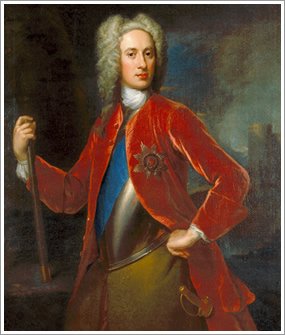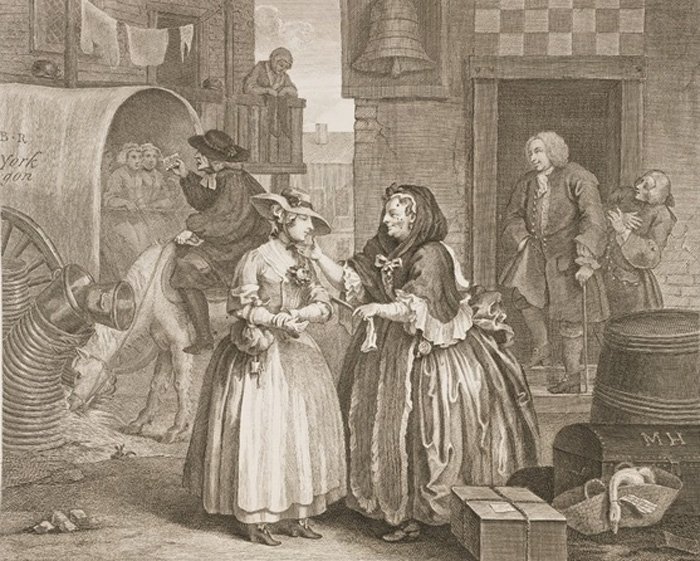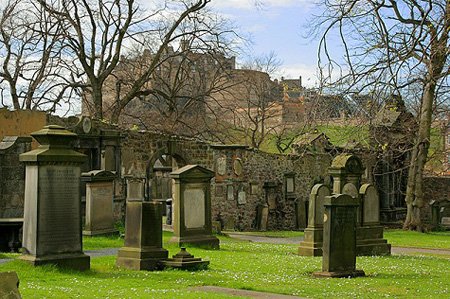Colonel Francis Charteris, gambler and rake

The “class system” in British society [1] grew out of the feudal system that Britain never officially abandoned (unlike most other European countries afflicted with that particular social disease). The transition was largely gradual – the privileges of the old lords, and the restrictions on the lower orders, gradually faded away. In medieval times social mobility was literally forbidden by law – sumptuary laws, for example, were designed to prevent those not born into finery from ever being allowed to wear it. As time went on and professions diversified, these laws naturally fell away. However other privileges, those not codified by law, proved harder to shake. The medieval lord took it for granted that those in his service were under his power, to deal with as he saw fit. The working class, on the other hand, knew their rights – and knew right from wrong. Naturally, this led to some conflict, as those with the old viewpoint came up against those with the new. So it was in 1730, when Colonel Francis Charteris found himself on the wrong side of history.
Francis Charteris was born in Edinburgh (or thereabouts) in the second half of the 17th century. His obituary would later give his birth date as 1675, but some biographers speculate that this was a mistake, and give 1665 as a more likely date. He was a member of Clan Charteris, who were actually descended from a Norman lord (William Chartres, a second son of the ruler of that French city) who came over with William the Conqueror. One of William’s family accompanied David I of Scotland north when he took the throne with English backing, and the family soon established themselves at court. By the 17th century they were among the great Scottish families, and Francis was born into privilege. He inherited the family title on his uncle’s death, though not the family estates. (His uncle had a daughter, and the estates were not entailed with the title, so he could pass them to her.) Still, he was well enough off to buy property at Newmills, near Haddington, and rename it Amisfield to match the estates near Dumfries he had not gained. Little else is known about his early career in Scotland.

His military career was somewhat less than distinguished. He enlisted at an early age, but was soon “drummed out” (a humiliating ceremony where the dishonourably discharged man was forced to parade before the ranks to the accompaniment of a drum beat) for cheating at cards. [2] He then went to Flanders to join a regiment there, but was again discharged – this time, apparently, for being caught stealing meat from a butcher’s shop in Bruges. He returned to Scotland, where his father bought him a commission in a Scottish regiment, but the officers there revolted and refused to enlist him. Still, he found another regiment willing to take him, and by 1711 he was a Lieutenant-Colonel. We know this because he appears in the records of the House of Commons, being rebuked before the Speaker for taking bribes to enlist tradesmen who had run up large debts – military service saving them from being arrested and taken to a debtor’s prison. Still, this time he was not discharged, and at some point he was promoted to Colonel (allegedly he won the rank at cards). He fought in the Jacobite Rebellion of 1715, though his loyalties were definitely suspect, and if the Jacobites had come out on top he would doubtless have turned his coat without a second thought.
Despite all of this, however, Francis prospered. He became notorious as a gambler not for winning money, but for lending money to other desperate gamblers and then seizing their possessions when they could not repay the debt. He also made a huge amount of money trading in the “South Sea Bubble”, one of the first notable stock market boom and crashes in history. [3] In 1727 he ran for Parliament, spending £100 a day (a lot of money for the time) on bribes, but still failed to secure enough votes to retain the £1000 deposit he had put down to run. The reason for this failure is pretty plain – not only was he a gambler, but he was one of Britain’s most notorious womanisers. The poet Alexander Pope said “his house was a perpetual bawdy-house”, and used his name as a byword for vice. He is often listed as a member of the first Hellfire Club and though this cannot be confirmed, he would definitely have fit right in. He was said to keep a harem of women at his castle in Hornby. He had married in 1702, and had a single (legitimate) daughter, but his wife lived apart from him in Edinburgh, while Francis made London his home. Here he employed a man named “Trusty” Jack Gourley to divert girls newly arrived in the city looking for work to his house in the West End. Francis was reputedly most fond of “tall peasant girls”. He was not that particular about consent, either, and gained the nickname of “the Rape-Master General”. In 1722 he was convicted of a rape in Musselburgh, near Edinburgh, but his wealth (estimated at around £200,000 – a fantastic sum at the time) was able to buy him a pardon, and the affair was generally hushed up. In 1729, however, Francis finally went too far.

Anne Bond was, by all reports, a devout young Christian girl, liked by all who knew her. She had several excellent references, and remained on good terms with her ex-employers. In other words, she was not the type of woman who would have taken service with the notorious Colonel Charteris. When she caught his eye, therefore, he simply gave her a false name, and told her that she was being hired by “Colonel Harvey”, a respectable retired serviceman. The practise of hiring young servant girls simply for their looks and then sexually abusing them was far from unknown, but Anne thought she had nothing to fear from “Colonel Harvey”. When she discovered his true identity a few days later (after several sexual advances and offers of money) she tried to leave, but the other servants prevented her from leaving the house. After she had been there two weeks, while she was preparing the fire in his room, he propositioned her again. This time when she refused his advances he threw her on a couch, stuffed her cap into her mouth to keep her quiet, and sexually assaulted her. When she said that she was going to go to the authorities, he laughed in her face, then had his servants whip her, take her belongings and throw her out the door, declaring to all that she was a thief being expelled from service. And a hundred years earlier that would have been that.
It was not a hundred years earlier, however, and Anne Bond was not without recourse. A friend of her’s named Mary Parsons (possibly a former employer) gave her shelter and helped her bring an official complaint against Francis of “assault with intent to commit rape”. Francis was indicted, and the grand jury (perhaps encouraged some of the many enemies that he had made with his ruthless moneylending) upgraded the charge to a full count of rape – which, at the time, was punishable by death. The trial was a public sensation, and the media reporting, another factor that would not have been present a hundred years earlier, was firmly on Anne’s side. Francis’ defence did their best to blacken her character (a rape defence still sadly much in use today), but three separate character witnesses gave a truer summation of her character. When a letter provided by Francis’ footman, supposedly from Anne, was shown to be a complete forgery then the case for the defence collapsed. Francis was found guilty, and sentenced to death.
The papers, of course, had a field day. Satirists found a new source to use to declare the corruption of the realm, while cynics opined that a man with a fortune so large, and with a daughter married into the aristocracy, would never hang. In this, they were correct. Francis spent just over a month in the condemned cell in Newgate prison before a petition, presented by his son-in-law the Earl of Wemyss, secured his release. One of the signatures, perhaps crucially, was that of Anne Bond herself. Whether this was due to her wish to not be responsible for his death (remember, her initial complaint was of a lesser, non-capital charge), or whether it was true, as the papers said, that she received a large financial compensation for the act, is impossible to say. (The same papers report that the following September Anne Bond’s new husband was arrested for debt, probably in a machination of revenge by the Colonel. The outcome is not reported, but one hopes that he was released.) Francis was released from prison, publicly reconciled with his wife and presented to the King as a man reformed.
Of course, this was far from the case. A few months later, he sued the Sheriffs for the return of his family estates (which, he having been convicted of a felony, were considered “attainted” and forfeit to the crown). The case was eventually settled out of court, with Francis paying several large fines (as well as several equally sizeable bribes). Ruined in public society, he was driven out of London and forced to move back up to Edinburgh. (Opinion was divided as to whether he had deserved hanging for his assault on Anne Bond, but it was generally agreed that he definitely deserved it for something, at least.) There he died in 1732, perhaps due to the illness he was reported as suffering in Newgate. An epitaph (written by a member of Pope’s writing club, probably John Arbuthnot or Jonathan Swift) declared
Here lieth the Body of Colonel
DON FRANCISCO;
Who, with inflexible Constancy,
And inimitable Uniformity of Life,
Persisted, in Spite of Age and Infirmity,
In the Practice of every human Vice
Excepting Prodigality and Hypocrisy
So hated was he that when he was buried in Greyfriars Kirkyard that the crowds of the city disrupted the service, attempting to force open his coffin and mutilate the corpse, and to throw dead cats into the grave with him. They hoped to ensure that, deprived of a good Christian burial, the “Rape-Master General” would be doomed to Hell, where he belonged.

[1] Best explained by this classic sketch from John Cleese and the Two Ronnies.
[2] In fact, Francis being expelled in the manner is one of the earliest known examples of it.
[3] In a pattern repeated down through history, the Bubble involved shares in the South Sea Company being traded up well past any realistic value they could intrinsically possess – and then crashing precipitously once people realised this. Other notable examples of this include the “Dot Com” crash fifteen years ago (involving trading in internet companies before the internet was mature enough to make them profitable), and most notoriously (about a century before the South Sea Bubble), the Tulip Mania that seized the Dutch. See “Extraordinary Popular Delusions and the Madness of Crowds” for more details.
